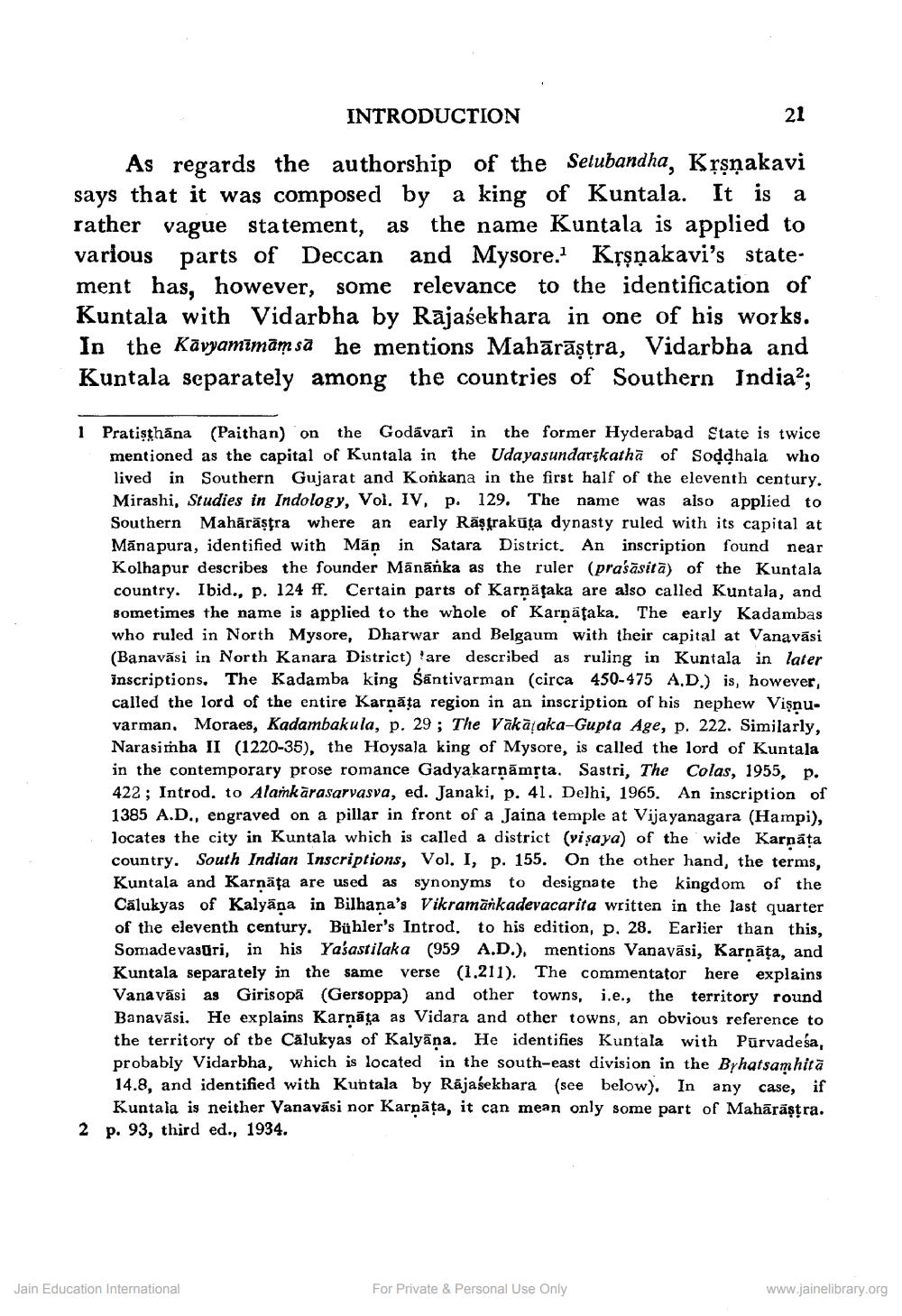________________
INTRODUCTION
21
As regards the authorship of the Setubandha, Krşņakavi says that it was composed by a king of Kuntala. It is a rather vague statement, as the name Kuntala is applied to various parts of Deccan and Mysore. Krşņakavi's statement has, however, some relevance to the identification of Kuntala with Vidarbha by Rajasekhara in one of his works. In the Kāvyamīmām sa he mentions Mahārāștra, Vidarbha and Kuntala separately among the countries of Southern India?;
1 Pratisthāna (Paithan) on the Godavari in the former Hyderabad State is twice
mentioned as the capital of Kuntala in the Udayasundarzkathā of Soddhala who lived in Southern Gujarat and Konkana in the first half of the eleventh century. Mirashi, Studies in Indology, Vol. IV, p. 129. The name was also applied to Southern Mahārāştra where an early Rāştrakūța dynasty ruled with its capital at Mānapura, identified with Mãn in Satara District. An inscription found near Kolhapur describes the founder Mānānka as the ruler (praśāsita) of the Kuntala country. Ibid., p. 124 ff. Certain parts of Karnataka are also called Kuntala, and sometimes the name is applied to the whole of Karnataka. The early Kadambas who ruled in North Mysore, Dharwar and Belgaum with their capital at Vanavāsi (Banavāsi in North Kanara District) !are described as ruling in Kuntala in later inscriptions. The Kadamba king śāntivarman (circa 450-475 A.D.) is, however, called the lord of the entire Karnāta region in an inscription of his nephew Vişnuvarman. Moraes, Kadambakula, p. 29; The Vākāļaka-Gupta Age, p. 222. Similarly, Narasimha II (1220-35), the Hoysala king of Mysore, is called the lord of Kuntala in the contemporary prose romance Gadyakarnāmộta. Sastri, The Colas, 1955, p. 422 ; Introd. to Alamkārasarvasva, ed. Janaki, p. 41. Delhi, 1965. An inscription of 1385 A.D., engraved on a pillar in front of a Jaina temple at Vijayanagara (Hampi), locates the city in Kuntala which is called a district (vişaya) of the wide Karnata country. South Indian Inscriptions, Vol. I, p. 155. On the other hand, the terms, Kuntala and Karnāta are used as synonyms to designate the kingdom of the Călukyas of Kalyāna in Bilhana's Vikramānkadevacarita written in the last quarter of the eleventh century. Bühler's Introd. to his edition, p. 28. Earlier than this, Somade vasuri, in his Yasastilaka (959 A.D.), mentions Vanavāsi, Karnāța, and Kuntala separately in the same verse (1.211). The commentator here explains Vanavāsi as Girisopā (Gersoppa) and other towns, i.e., the territory round Banavāsi. He explains Karnāta as Vidara and other towns, an obvious reference to the territory of the Cālukyas of Kalyāna. He identifies Kuntala with Pūrvadesa, probably Vidarbha, which is located in the south-east division in the Byhatsamhita 14.8, and identified with Kuntala by Rajasekhara (see below). In any case, if
Kuntala is neither Vanavāsi nor Karpāța, it can mean only some part of Mahārāştra. 2 p. 93, third ed., 1934.
Jain Education International
For Private & Personal Use Only
www.jainelibrary.org




